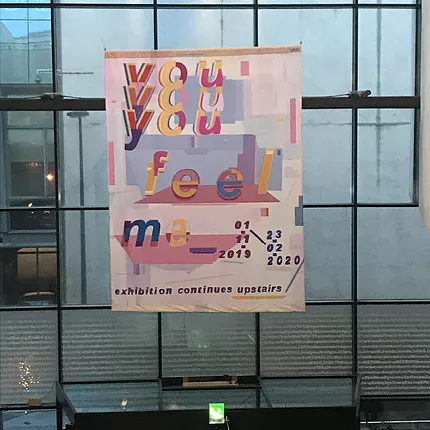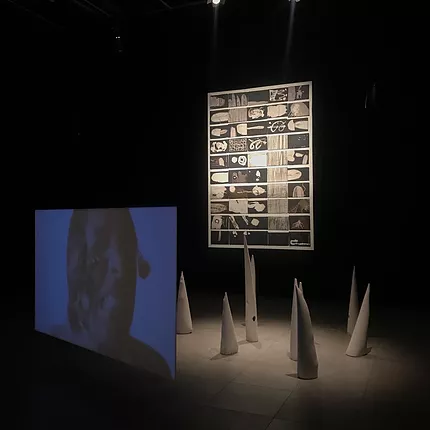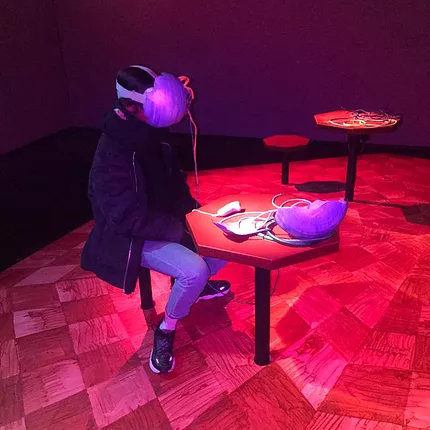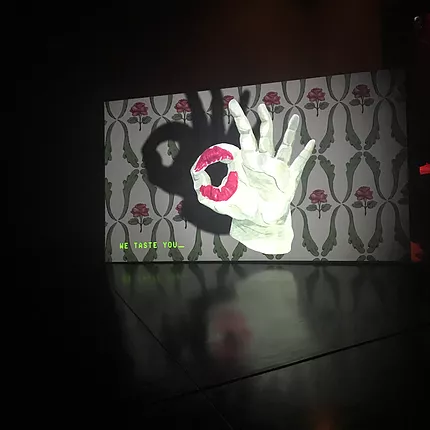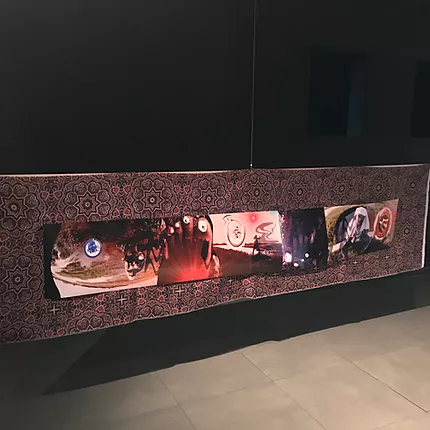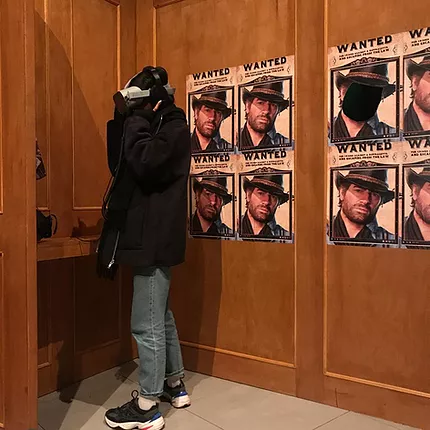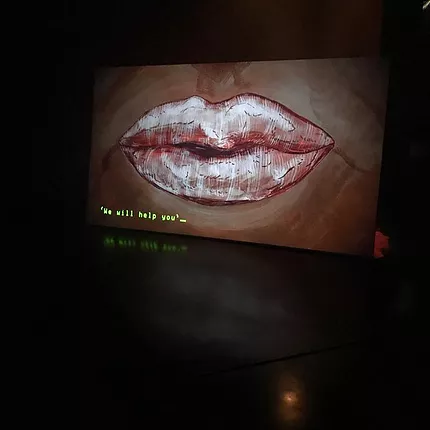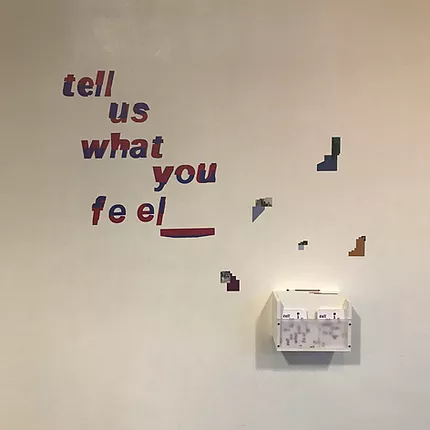you feel me_ @ FACT, Liverpool
ZM
Emoji summary: 🕳 🚦 🔀
I don’t think I’ve ever seen a show at FACT that I’ve felt good vibes from. Tbf I haven’t seen much, but every time I go, I’m plunged into this Science Museum kinda dark room w spotlight set up. I just don’t think it gives me good vibes tbh, it’s so subjective, so specific to me, but it makes me wana leg it out of there. D’you ever think like, if buildings can have character, they aren’t necessarily all nice ~people~? Like, I’m sure FACT is an arsehole.
<you feel me_> is a group show at FACT in Liverpool. I nipped up for a cute friend weekend: Me n Gab ate good vegan burgers, I went into the massive LUSH, spent time w Gab’s enormous family and friends we’re always too busy to see when we’re working. I caught this show in between all of that Life; it feels unfair bc I hate the vibe of the building, and against that stark backdrop of Wholesome Good, it feels amplified. I didn’t think I wanted to write about this show then, because of this very reason. My own bias against the lower gallery alone is enough to skew any review, mess up any good mood. But the evening before we went to see it, Gab whispered to me in hushed tones about the Art Monthly review, airdropped it to me n we had a silent stare.
The show itself, I never thought I’d say this but I think it’d look/feel better in a ~white cube~. I’ve never wanted white walls more, wallah. Look at us, who’d have thought it? Not me. The work was broad at a glance, a mixed bag and bound loosely. Phoebe Collings-James’ work was the first to greet me at the door. Sculpture: little white peaks, irregular and tilted, little eyeholes all in a cluster. Ceramics: grid of black tiles on the wall behind that, beyond figuration but there’s a thick-legged spider, something with a tail and a boot and a clog hovering over what looks like a little egg, stripes and blobs seeping. Video: Phoebe wears a mask made of net, tightly woven, held close round her face, there are little bells sewn into it and she shakes her head, trying to cast it off and ringing them as she goes. A short jump over, Brandon Covington Sam-Sumana’s panels are beautiful paper moments pinned to long fabric sashes. There are 2 of them, facing into each other, between them a piece of quilted puff, embroidered and with a bullet belt draped across it. Then Rebecca Allen’s long, aching moving painting. Blurry, slow and pale; I love it the most, but only slightly. Upstairs, there is Anna Bunting-Branch & Aliyah Hussain’s VR work; a chunky theatrical stage set up, full-scale production. I slip into a seat and plop the headset on and it’s a stuttering, lyrical animation, it looks hand drawn. I really couldn’t tell if there was a narrative I was meant to be swept up in, I was just happy to lean into the wave as it moved gently in front of my lil eyes, a centimetre from my blinking eyelashes, like little cells and eggs dancing around with exploding excited lines. I enjoyed the proximity, to sight & sound; I think the only times I have ever felt truly ~immersed~ is with long VR pieces; Jon Rafman (cursed), Danielle Brathwaite-Shirley (babe), maybe I’m into it as a format. In a smaller room to the side is a kinda dense film, animation again, about heavy feminist linguistics - woman as Other, but also Other as Other, intuited bodily ancestral knowledge n the emergence of language from the body (whatever that may be). I think if I’d spent more time with it, I’d have loved it the most (maybe). But as I’ve declared already, something about FACT makes me wana spend no more than 20 minutes in there. I’m so sorry.
I think this feeling about me hating the building is not as unimportant as I’m making it sound, beyond me being blasé about rooms being arseholes, I think the way FACT’s galleries hold space and leak over to the artworks affects the curation of anything that’s put in it. They seem to swallow things up, make them look small and isolated, like little islands. The curation of the works in theory is genuinely interesting - this slow rub of word, action, Other, somatics. It is a show that feels researched but not clunky in the way it imparts that research, like it’s literally j vibing w those themes around it - it still feels broad and loose when you try and gain purchase into it. But somehow the rooms at FACT j swallow the works up in person, make them feel like they’re individually packaged. I don’t think there’s any other way to navigate the space, no point dwelling on better placement or assigning blame to the curator, because even if the works were all arranged differently in the space, it’d still feel weirdly empty without being sparse. It’s a lose-lose room imo. The works look good in photos but in person feel haunted bc of the dead dark space around them; I think it’s a shame bc I’d have rly fucked w this show if it was anywhere else, or if they’d just turned the lights on.
Then the review. Laura Robertson reviewed this show for December’s issue of Art Monthly. It’s not that there’s anything explicitly Bad-Wrong with it. I just think it is Interesting. <you feel me_> is the first exhibition by Helen Starr, who’s FACT’s Curator-in-Residence, Helen is also the first Black curator at FACT. In the hand out (designed by Salma Noor, whose work is the show’s ~exhibition identity~ - something I absolutely love as a phrase/thing n also as work in n of itself), Helen describes herself as an ‘Afro-Carib Trinidadian Blixn (Black womxn)’. In Helen’s Curator Blog post for the show - on FACT’s website - she writes ‘I wanted to create an exhibition for FACT using a form of knowledge common to my ethnicity - known historically as Black Carib, Zambo, and in colonial Mexico - a favourite, lobo (“wolf"). I have a discursive, inductive way of thinking that is common to indigenous people’. The curator’s identity isn’t just there to be interesting or make the rest of the FACT programme feel more diverse; from the curator’s blog, it feels like it was actively a reference point for Helen as she bound these works together in the show. ‘To students of physics and indigenous people, sound exists as more than we can hear. Sound can be defined as a wave resulting from vibrations as particles release and absorb energy in the mediums through which the sound travels - water, air, or flesh. The lower frequencies register as “felt sound” - the knowing feeling as you approach a waterfall you cannot hear or see yet. That sound, which is felt through the skin, moves you through the land like a map charted inside your body.’ While, for me, sound is by no means the singular underlying backbone pinning the works together; I feel like this text Helen has written identifies that the West has a pretty limited understanding or articulation of where sensory categories are capable of bleeding into each other. She continues, to confirm this, ‘Received Pronunciation, the standard in British media broadcasting is not a rich, evocative, or tonal sound.’ That the very nature of what is recognisable or assimilable as British/Western is identified within the text as a limited, contained category, partial and incomplete, feels to me like an identification that what’s most interesting about the works is that they engage with that liminality in between, that rests beyond what the West can understand within its system of categorisation. All the works in this show are either in that sticky in between - mucus lining - or they are conduits through which that same stickiness is articulated - phlegm. All of them are able to articulate this felt stickiness beyond the comprehension of Whiteness. It is an active, erupting reference point that runs throughout the show.
That’s what makes Laura Robertson’s review uncomfortable and lowkey highkey violent to read through. She writes that Phoebe Collings-James’ tiles ‘record[] a private litany of scrawled messages’, including the word ‘pigeon’, but all I saw was the the word ‘Paigon’ (upside down and above a Bird sketch) on a panel. This specific confusion isn’t the peak of the discomfort, but it feels illustrative of the way Robertson’s text insists on examining the works, at large, in the rigid categories of Western thought & conception. Robertson seems to brush past the talk about destruction and comes to dwell on the last line of the handout’s introduction: the promise of ‘ultimately bringing us to a space of healing.’ To me, this line feels more about re/presenting these articulations of stickiness, phlegm and mucus, as a retribution or resolution in and of themselves. These articulations exist, they are real; that is a challenge and an inversion as it stands, on a purely representational level alone, as an attempt at a refusal. But Robertson’s text seems to search for healing as a transformative spectacle for the viewer: ‘It's all in the edit. I hate the click-bait title and am suspicious of the guide's promise of artworks that will bring us, ‘to a space of collective healing'. Who wiII heal me and how?’ Oh babes…. ‘My mind and spirit do need healing; I'm tired of the world and of the news. I very much like the intention - 'a group exhibition of seven artists critiquing and disrupting dominant systems of control’’. I don’t think she liked it beyond the intention, bc she goes on to say: ‘I want to see more artworks that kick back against the status quo’. Maybe there was an issue in the way the handout text used specific and loaded language that speaks louder to a white viewer and their expectations, with all the dwelling on ‘critique’ and ‘disruption’ but all the same it’s a weird review, where the critic ~almost~ circumnavigates her own intrusion and entitlement to inclusion in this articulation (almost admits to it herself: ‘healing might not be on the table for me here’). She describes it there but never names it fully, or dissects the fact that there could be value in still persevering towards understanding and engaging with something she can’t really be party to. An insistence on understanding it only on her own terms rather than surrendering to the logic of anOther, a wanting for work that fetishises the language and aesthetics of ~change~ & ~disruption~ rather than work that manifests a break from existing systems. It’s a weird thing to read, even weirder to see it come out of Art Monthly - a magazine with a relatively good track record for the most part. But for me, the reason I mention it here isn’t to j be baffled for the sake of it; it raises a question I think I’ve not really wanted to address since I tried to forget about the violence of Making. How can any maker that isn’t speaking to, about, or in the language of Whiteness (as category, as abstract, verbiage, or as something as hard and insoluble as identity) expect any kind of understanding, LET ALONE, complicity from an audience? I sound like a broken! fucking! record! But the Gallery, as a model and a replicated system of exhibition and display of artworks, goes to great pains to ensure that the majority of their audience are White. Is it even possible for understanding to emerge as an expectation? What do artists of colour/outside of the West and its lumpen fucking canon and categories do then? It is a stuck-ness; a sticky liminal, but not the good tingly kind that the works deploy. It is blackhead, sore, pus. For all the wide-eyed panic Laura Robertson’s review squeezed out of me, tbh she identifies this without quite realising what she’s hitting at. Talking about Phoebe Collings-James’ video work <MOTHER TONGUE/MOTHER MASTER>: ‘It's exhausting trying to make yourself heard, isn't it? It requires, at the very least, people willing to listen.’ Pfft. I mean…
you feel me_ is on at FACT in Liverpool until 23rd February. If you missed the links: Helen Starr's text for FACT's Curator's Blog can be found here, and a pdf of Laura Robertson's review for Art Monthly can be found here. I unfortunately highlighted bits for my own reference while writing n i cba to undo them j to upload it, but pls don't take it as me directing ur attention to specific parts of Robertson's text! i am j a lazy gal. But I think I also should mention that Robertson misgenders Brandon Covington Sam-Sumana, who's written about with they/them pronouns in the handout. Anna Bunting-Branch’s VR work doesn't just have female characters. Phoebe Collings-James' ceramics aren't finger painted either. I think these mistakes are incredibly unfortunate, and should have been caught by both the writer & editor. I think the instance of a White critic writing badly about non-Western concepts is so banal it's actually normalised, and That should be thought about/considered when commissioning writers, esp when disruption is a word on the table.
